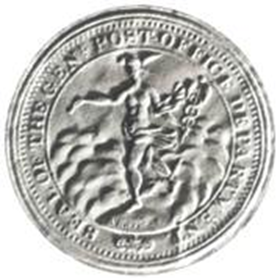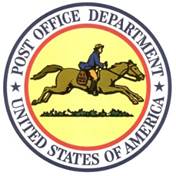
The History of the Iconic USPS Seal
Our seals and logo visually represent our commitment to serving the nation.
The history of the United States Postal Service has both reflected and influenced the many ways our country has evolved since its inception. As the historian of the Postal Service, I see examples of these reflections and influences all around me. One example is the evolution of the Postal Service’s official seal.
We have had several official seals in our nearly 250-year history. In that time, we’ve used Mercury, the Roman god; a post rider on a horse; and a bald eagle to represent our service to the American public.
For a country founded partly on ideas inspired by the ancient Romans and

Greeks, it was fitting that one of our first official seals featured Mercury, known in Roman mythology as the winged messenger of the gods and also as the god of commerce and travel. By using the symbol of Mercury, the Post Office Department communicated to our young nation its commitment to the swift, secure delivery of its correspondence.
The Mercury seal was used as early as 1782, and the image evolved over time. The final version featured Mercury holding a letter in his raised right hand, standing on a globe labeled “America.” Interestingly, though, it was not until a Congressional act of 1825 that the postmaster general was officially directed to “procure and cause to be kept, a seal” to authenticate commissions sent to postmasters and other important documents.

Following a disastrous fire at postal headquarters in 1836, a new seal was created featuring a post rider on a horse. It was officially placed into service on May 1, 1837. There is a lot of symbolism attached to this seal, from its supposed similarities to a woodcut used by Benjamin Franklin, to the Post Office Department’s role in the country’s westward expansion. The post rider also symbolizes the pivotal role the Post Office Department played in connecting the nation’s most remote communities — a role that continues to this day.
Contrary to popular belief, the rider-on-horse image does not represent a Pony Express rider. That legendary enterprise did not exist until 1860, more than two decades after this seal was introduced.
Official seals — especially for government entities — hold a lot of significance. They are symbols of values and history, and a statement of an institution’s identity. By the mid-20th century, the rider-on-horse seal was showing its age. Times had changed.
On Aug. 12, 1970, on the same day President Nixon signed the Postal

Reorganization Act into law, our iconic bald eagle seal was unveiled. The bald eagle encompasses everything the United States Postal Service stands for. The seal is modern and forward-looking. It also embraces the very symbol our nation’s founders chose to represent America’s strength and freedom.
The image of the eagle poised for flight remains the official USPS seal to this day, but you are probably more familiar with our Sonic Eagle Logo, which was unveiled on Oct. 12, 1993.

This logo has adorned our Post Offices, collection boxes, vehicles and uniforms for nearly 30 years. It captures — even more dynamically — the forward-looking spirit of today’s USPS as we transform into a modern, self-sufficient Postal Service for the 21st century. Just as importantly, our current logo, as with each of our seals, is a visual reminder that USPS is, and always will be, changing with the times to best serve the American public.
Jennifer Lynch
Historian & Corporate Information Service Manager